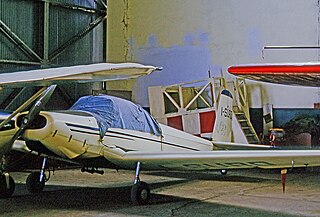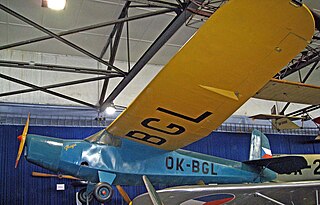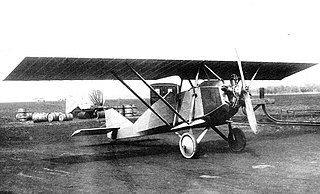
The Aviamilano P.19 Scricciolo was a light civil trainer aircraft built in Italy in the 1960s.

The SAI-Ambrosini SS.4 was an Italian fighter prototype developed in the late 1930s, featuring a canard-style wing layout and a pusher propeller. Development of the SS.4 was abandoned after the prototype crashed on its second flight.

The Praga E.114 was a single-engine sport airplane, designed and manufactured by the Czechoslovakian company ČKD-Praga. Due to its light weight it was also called Air Baby.

The RWD-16 was a Polish two-seat low-wing sports plane of 1936, constructed by the RWD team, that remained a prototype.

The de Schelde Scheldemusch was a single-seat pusher biplane designed in the Netherlands to be easy and safe to fly. It was one of the first light aircraft to use a tricycle undercarriage. Despite a sales campaign in the UK, only six were built, one being briefly tested by the RAF. A single example of a flying boat version, one of the smallest of this class, was also built.

The PWS 3 was a Polish sport aircraft, developed in 1927 by PWS, which remained a prototype.
The I.S.T. L-17 Masang was a two-seat, single engine, low wing monoplane aircraft designed and built in the Philippine Republic in the mid-1950s. It was intended for both touring and training.
The Iannotta I-66L San Francesco is a 1960s Italian ultralight designed to be homebuilt from plans. It has been powered by several flat-four engines in the 65-100 hp range and built in both single and two-seat tandem configurations. Only small numbers have been completed.

The twin-engined CANT Z.1011 was one of two bombers of about the same size and powered by the same engines, designed by Filippo Zappata in the mid-1930s. The other was the three-engined CANT Z.1007, which in the end was the type preferred by the Regia Aeronautica.

The Savoia-Marchetti SM.80 is a two-seat monoplane amphibian tourer, with a single, tractor engine mounted above the wing, designed in Italy in the early 1930s. The SM.80bis is a four-seat variant, powered by two pusher engines.

The SAIMAN LB.2 was an unconventional Italian two seat cabin side by side sport aircraft designed around 1937, with a single pusher configuration engine, twin tail booms and an early tricycle undercarriage.
The MSW Votec 252T is a single engine kitbuilt light-sport aircraft with side-by-side seating for two, designed and built in Switzerland and was first flown in 2009. By October 2011 only this first prototype has flown.

The Legrand-Simon LS.60 is a single-engine, high-wing monoplane seating two side-by-side. It was built in France in the early 1960s in response to a government competition for a club trainer. It won the competition but nevertheless failed to go into production; only the prototype, which still flies, was completed.

The Coupé-Aviation JC-01 is the first of a series of very similar designs of two seat, single engine sports aircraft, amateur built from plans in France from 1976. These provided a range of engine sizes and undercarriage layouts, but total production was small.

The Kondor D 6 was a prototype German biplane fighter aircraft flown in 1918. In the interests of better upward vision for the pilot, its upper wing was in two halves, separated over the central fuselage. Its development was soon abandoned.
The ViS Sprint is a pusher configuration, pod-and-boom two-seat ultralight, designed and built in the Ukraine in the mid-2000s. It can serve as an agricultural spraying aircraft.
The Aviator Shershen' is a Russian two seat biplane, sold in kit form. It first flew in 2005 and several variants have been produced, with a choice of engines.
The Bonomi BS.19 Alca was a single seat, tractor configuration motor glider, designed and built in Italy shortly before World War II. It had an unusual retractable undercarriage used only for take-offs. Only one was built.

The Caproni Ca.95 was a large, three engine, long range, heavy bomber prototype built in Italy in 1929. It could carry a 1,600 kg (3,500 lb) bomb load and had three defensive gun positions. Only one was built.
The MIP Smyk, MIP from the initials of its Polish designers with Smyk meaning Brat or Kid, was an aerodynamically refined motor glider designed and built at Warsaw Technical University from 1935.













